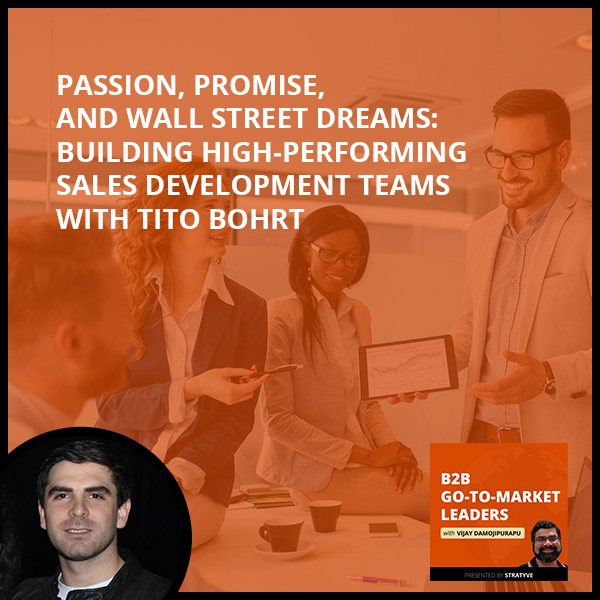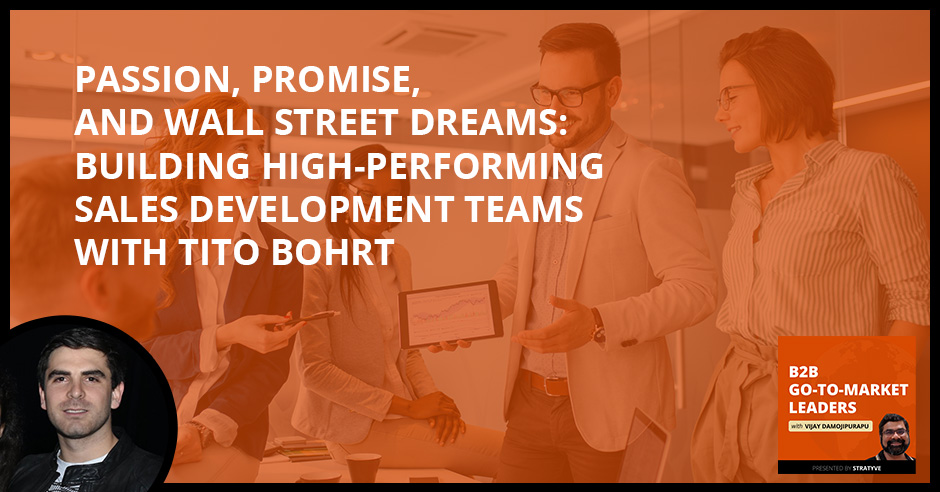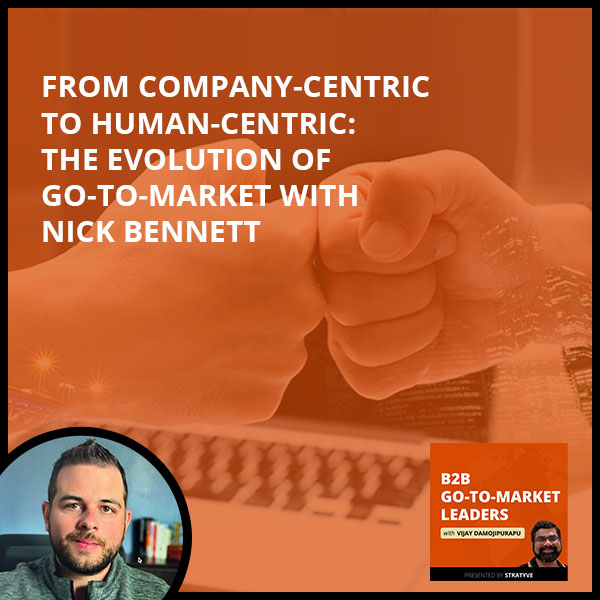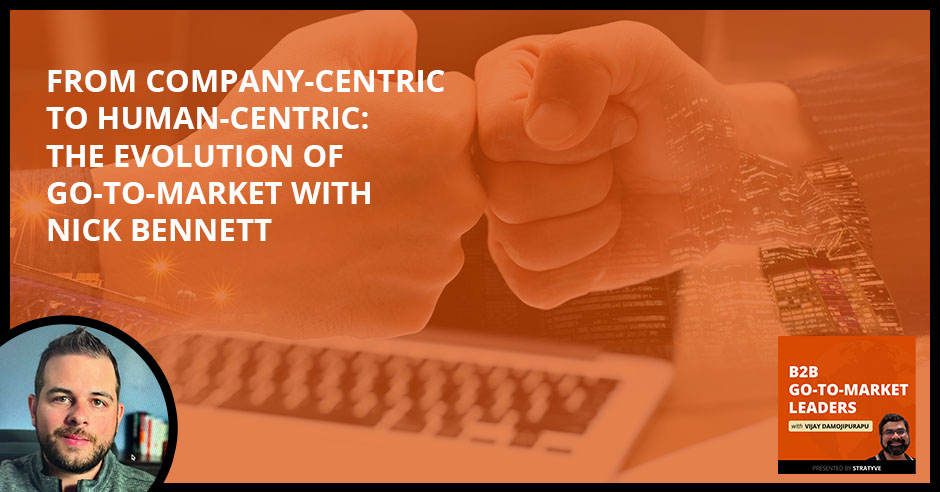

Sales isn’t just about hitting the numbers; it’s about creating transformative partnerships, driving revenue growth, and making Wall Street dreams a reality. In this episode, we dive deep into the world of sales development and go-to-market strategies with Tito Bohrt, founder and CEO of AltiSales. The discussion kicks off by shedding light on a common pitfall in sales development: focusing solely on meeting quotas. Tito reveals the flaw in this approach and explains why exceeding expectations and delivering real revenue outcomes should be the ultimate goal. As the discussion unfolds, Tito reveals how his company has transcended traditional sales development, transforming it into a venture capital powerhouse. He shares how his team not only sets up meetings but also invests in early-stage companies, taking on shared risks and reaping rewards alongside their partners. Tito also delves into the nitty-gritty of setting up successful sales development teams and shares the meticulous operation he has built. He emphasizes the importance of finding fulfillment beyond monetary gains and shares the heartwarming story of his promise to his mother. If you want to discover how to break free from conventional norms, deliver exceptional value, and ignite the true potential of your sales team, then this episode is for you. Tune in now!
—
Listen to the podcast here
Passion, Promise, And Wall Street Dreams: Building High-Performing Sales Development Teams With Tito Bohrt
I have an exciting guest. I have with me Tito Bohrt, who is the Founder and CEO of AltiSales. He is championing the world of SDR. I’m curious and interested in knowing and learning about the story behind SDR and what prompted Tito to get into this. Without further ado, I’m going to welcome Tito. Welcome to the show.
Thank you. It is great to be here.
I’m going to start with the signature question my readers look forward to, which is, how do you view and define go-to-market?
I define go-to-market as the set of motions that a company has to do to get net new customers. That will involve, according to the type of company you are, potentially different teams. It could include marketing, sales development, and sales. If you have PLG motion, it could include the product. If you are not a PLG product, you won’t include the product. It is the set of motions from the people who are interested or involved in achieving net new customers.
I like the aspect and point that you did call out the product. That is something I see most folks miss out on. Kudos to you for that. I like the fact that you are bringing in and tying in all the key functions that, include product marketing and sales. Something that caught my attention, which you emphasized and focused on, is net new. What about the expansion piece within existing customers?
You are saying, “Go-to-market.” If you are going somewhere, you are not yet there. If you are expanding, you are expanding something where you already are. That can’t be go-to-market. That might be stay-in-market or growth-in-market, but it is not go-to-market.
I never looked at it from that angle. It is interesting you share that perspective. I will keep my eyes and mind open on that part.
I believe that renewals, expansions, cross-selling, and upselling are incredibly valuable, but I do not consider them as go-to-market. They fall outside of that definition.
Something else I had done and seen, especially when I was leading product marketing and marketing teams at early startups, there is acquiring new logos, which is a net new opportunity. There is also the aspect, especially in more mature organizations, when you are looking to add a new product to the product line, you are looking to expand, cross-sell and upsell within the existing accounts. In that perspective, it is a sliver of a go-to-market of a new product within existing accounts.
If you are going with a new product to these accounts, you would say you are in go-to-market motion for a new product because you are penetrating new territory.
That is a context setting for the readers. Let’s deep dive more into your story. Can you share a bit about your career journey? Why, and what prompted you to get into sales and SDR? What do you do now?
I will keep this short because I could spend a whole hour talking about the whole journey and how I got to where I am. I started the company I now run. I started version 1.0 of the company I ran when I was in college. I had a different company. I had a textbook marketplace. It seems like everybody and their mom has started a textbook marketplace in college.
I did this at Duke University. We were fairly successful there. I sold $50,000 worth of books during our first semester. Through that, I met a Duke alum, and while speaking with them, I learned they had an SDR team. They called it lead generation. There were a bunch of people making outbound calls. I read a book about outsourcing and moving operations to Bangladesh and different places for low cost.
I asked them why they weren’t doing that. That spurred a conversation into them wanting, due to language reasons and time zone reasons, people in the US. I had a better idea, which was all my friends in college wanted to travel. Why don’t we set up shop in a beautiful location like Costa Rica or Mexico? You set up operations there and hire people in the US, but you let them work abroad for six months.
That was version 1.0 of the company I launched. I run with it for about three years up until 2015. We only had them as a client. They became my client when I proposed that idea. We shut that down for a few years. I worked in Silicon Valley, and I restarted the company again with the same name. It is AltiSales.
The concept was a little bit different. I understood that employees could work remotely. They could work from anywhere. What was a constraining part was trying to set up a team in Costa Rica, bringing people from the US and hiring a few local employees. Our talent pool was limited. I wanted to create a company that was 100% remote. You can work from anywhere in the world. As long as you were excellent, we would trust you. We would build the right metrics and processes. You could work with us.
Nowadays, that concept has further evolved. 2.0 was a fully remote outsourcing company. What I would call AltiSales 3.0, which is the current version is. As we started outsourcing, all our clients were wondering how our processes and our SDRs get 2, 3, to 4 times more successful meetings, pipeline, revenue, or however you define it, than their internal SDRs.
We started consulting. As we were consulting, our clients wanted our metrics. We also launched our software. AltiSales 3.0 is a company dedicated to being a go-to-market accelerator, mostly for B2B SaaS. We have had a few clients outside of SaaS as long as you are an enterprise. We do it through cold calling and cold email. We can also do internal audits of your team. We also provide you with some tools that have been the key to our success. If you start using them, they will lift performance. That is where we are now. We have a big vision for where we are going, but I will save that for another time.
I can pinpoint and pick a lot of places or points in your journey, and we can dive deep into that. Let’s do that. The first point in your journey that I want to dive deep into, Tito, is back when you were at Duke, you launched this company named Shelf Relief. Somehow you got the founder’s DNA. Were you aware of that? What prompted you to even start a company in the first place at Duke?
Both my parents are entrepreneurs. They run their own businesses. When I was a kid, I thought I would work in the family business. I had a vision of finishing college, working for a few years, getting an MBA, working in the family business, and running that or starting my own when I was 30-something. Life goes faster than you think. I’m in my early 30s. I have been running the company for several years. I have been more successful than I ever thought I would be. It is exciting.
It was in my DNA because my parents were like that. I saw my dad sometimes work Monday through Saturday, ten-hour days. He gets home at 8:00 PM. Sometimes I see him take every Wednesday off to go golfing. That is the beauty of being an entrepreneur. You decide the intensity at which you want to work. I loved both his passion and flexibility in how he approached life.
The beauty of being an entrepreneur is that you get to decide the intensity at which you want to work. Share on XThose two things that you mentioned stand out for me, which is freedom, which you refer to as flexibility. You are committed to something. When you are an employee, you are getting a steady paycheck, but you are not digging into why you are working, where you are working, or what is getting you to get up every single day. Imagine the other state where you don’t have any income and clients, but you want to figure out what will wake you up in the morning, get you excited, and do that day in and day out. That is the passion piece.
The most helpful thing for me was to be an employee for a period of time. I was an employee at a few other companies. I approached it as an entrepreneur a little bit differently than most other people approach it. A lot of people that have an entrepreneur DNA take a job and don’t put a lot of effort or heart into it and try to work on their side hustle as much as possible because they want to do something for themselves. I approached it the complete opposite way. I went all in and deep into making that company as successful as I could.
The reason I did that is I saw it as a learning experience. If I can do it for Reputation.com, App Buddy, or the companies I worked at, imagine for myself, I can do it for myself. If I could build a pipeline, create a go-to-market strategy, build a data research team, set up CRM, and do this, I tried to do it as perfectly as I could, and I worked long hours.
The way I transitioned from my first job to the second job in the interview, they asked me, “What is one thing that you know at your company that nobody else knows? What is your competitive advantage that is making you successful?” My answer to that was, “The lights at the office turn off at 11:30 PM, and there is no way to turn them back on.” I will be in at 11:30 PM in the office almost daily. I was dedicating my life to work. I thought it was important. I wanted to be successful. I’m hungry for success at that moment. It turned out good. It paid off, but I worked for somebody else. I worked hard for those businesses. I saw it as a way for me to learn.
I checked out one of the videos you created when you launched, and you are running Shelf Relief, which is the how-to and explainer video about the marketplace for selling used textbooks. Was it all you who created and wrote that script?
I wrote the script.
Readers, you should go and check it out. I add it to the show notes. What it tells me is there is a marketer in you. How do you tell the story?
My background is in behavioral economics and decision neuroscience, which is the science behind how people make decisions and what persuades people. I was no expert in copywriting, but I found Epipheo Videos, which is an outsourcing agency or a company that would create videos for products. I found their YouTube channel, where they would publish all their videos. I found their library online. I had to watch 2 or 3 of their videos in the past, not knowing it was them. They were all fascinating and excellent.
I have also read books like Made to Stick, and Contagious is another one. All these help you understand the psychology of virality. With those, I reverse engineer the steps of the video. How are they creating these? What is a formula? If you have only 2 or 3, you can’t do it. Once you watch 25 of them, you could reverse engineer their process. I inquired with them to see if they wanted to build my video. The cost was $25,000 at the time, maybe higher. I didn’t have the money. I hired a freelancer on Upwork for $800 to do both the video plus the voiceover, and I wrote the whole script.

You got a good template, and you study the playbook inside out as to how to explain a video should be. Always start with a problem. You also talk about the alternatives and why your solution is better than the alternatives. You don’t focus on how you are going to address their pain point, which is buying and trying to sell books. They are getting only pennies on the dollar for the book they are selling. You also talk about easing their pain point after not using the purchase, but it is almost like a complete life lifecycle. You have them for the complete lifecycle.
The market is small. When you are in college, you think that textbook costs are the craziest and biggest problem in the world of a student. Once you realize all the other problems you can solve, you realize it was tiny, and there are better things to focus on. It is fun learning.
When you're in college, you think that textbook costs are the craziest and biggest problem in the world for a student. Then once you realize all the other problems you can solve, you realize that that was tiny and that there are better things to focus… Share on X
In hindsight, you are able to connect the dots. That was a connecting dot to the next big thing, which is AltiSales 1.0. That is where you said you hired folks in the US, but you get the flexibility and option for them to work from exotic places.
We would set up an office in Costa Rica, Mexico, or Bolivia. We would fly a group down altogether on the same day. We would give them apartment space. There is a cleaning service that cleans their house once a week. We had adventure sports, water rafting, bungee jumping, jet skiing, or whatever we could find nearby. We would organize weekend trips, ATV riding, or whatever came to mind. It was a lot of fun.
The company in the early stages, AltiSales 1.0, was based on the premise that by locating your team in a lower-cost-of-living location, you could make it more cost-effective. It wasn’t about being an excellent sales development team. It was about being as good as your in-house team, except a little bit cheaper because it is in a lower-cost location.
That worked for a while. It gave me the opportunity to become one of the best sales development leaders in the world. I run sales development in 0.01% of teams in the world. I understand how to architect, execute and optimize everything within sales development much better. That led to 2.0 and 3.0, where we are focused on building world-class sales development teams for companies.
Can you shed some light on your system? I have studied entrepreneurs and marketers. There is something magical. Take the example of the NBA league. You got 30 teams in the NBA, but only the top 1, 2, or 3 teams consistently win the matches day in and day out. If you dig deeper, they have a system around how they train each player and how and what role they give to each player during every game system around creating playbooks. They have a system around mindset, the coach upping his or her game, and the players. There is the system, process, and training that goes behind it before the actual game. Similarly, it looks like you mastered a special source system for your company around SDR and sales development.
There are some things I can talk about. There are some things that I can’t talk about in that system. We believe SDRs solve problems, not solutions. It is step number one. Number two, everything gets measured and managed. We look for leading indicators rather than lagging indicators of success. The way we manage and think about our team’s success is slightly different.

I talk to SDR leaders that are still asking, “How many dials did my SDR make now, this week, or this month?” Those are some of the principles. When I’m evaluating the performance of an SDR, the first thing I look at is how many meetings have been completed. Have they gotten every month with the target accounts and the right buyer personas? If they haven’t had the number of meetings completed, I look at the number of meetings set. If I don’t have the number of meetings set, I look at the number of conversations. If they don’t have the number of conversations, I look at dials.
What that allows us to do is focus on outcomes rather than inputs and get the SDRs focused on their outcomes rather than their inputs. If I can get to my goal of 60 dials a day, nobody cares. If you are not getting the goal of 60 dials a day, that trickle-down effect will get us to ask you about the dials and the effort you are putting in.
At the same time, we know what the benchmarks of conversions have to be. By starting at the bottom of the funnel, I say, “Your show rate should be about 80% to 85%. If you are in that range from the meeting set to meetings completed, you are good.” Let’s say your goal is ten meetings a month. If they are setting fifteen meetings and they are only having eight complete, I’m like, “You are at 53%. That is not going to cut it.” We have a checklist on how to troubleshoot your show rate.
It is the same with the calls. We know what our connect-to-meeting ratio needs to be. If 100 people pick up the phone, how many meetings are we going to get? I know what that number needs to be across our clients. If they are not there, I’m going to dive deeper. When I’m diving deeper, I don’t say, “You got to make more calls. You got to improve your conversion.” I say, “If you make a phone call, and somebody says, ‘Hello,’ what is your opening line?” Within the opening line, what percentage of time should an SDR have their opener turn into a pitch? That for us is in the 80% something range. If you are not there, I have a checklist on how to help you improve your opener.
You got a detailed system. If you talk to most CROs or marketing and sales leaders, they will talk at a high level about the conversion metrics between sales stages or marketing stages. What stood out for me, Tito, in your system and the way you are thinking about it is you are going down to the minute in the life of an SDR on any given day, and you backtrack.
The outcome is the meeting show up. The meetings they booked are one thing, but showing up for the meetings is a real success, and that is when they hand it over to the AE. Before that, there are steps leading up to that point. You nailed it down. You mentioned a lot of times the outbound calls and phone calls. Is it only outbound? Is that the only channel you are relying on, or do you explore others, like emails?
We are multi-channel. We are doing LinkedIn, email, and phone calls depending on the type of interaction. Sometimes when our SDRs interact with somebody, the prospect says, “Can you send me a quick email?” We say, “Do you mind if I send you a text message instead?” The prospect might say, “Yes, that works too.” Now we are texting with a prospect’s permission. We do LinkedIn ads for certain clients, especially when there are specific target accounts they want to get into. We have a system to do specific ABMs. It is multi-channel. We think that is the way you win.

You alluded to what works for outbound and outreach. It is not just phone calls, but it is multi-channel. Going back to the go-to-market tactic, that makes sense, given the context of your customer or client.
You got to be smart about it. If you are doing this well, channels are feeding off each other. When you leave a voicemail, you say, “John, I’m sending you an email. There is no need to call me back. My name is Tito. I was trying to XYZ123.” That is a good way because people don’t call you back on voicemail, but they will go open your email.
It is similar on LinkedIn. You can say, “Did you see my email?” On a phone call, sometimes they will say that too, like, “Can you send me an email?” You can say, “Yes, I will connect with you on LinkedIn. I sent you an email a few days ago, but I will ping it back to the top of your inbox.” You reply with a ping. It will come to the top of the inbox, and they will see it. Those strategies work.
This is where I see your Duke Major in Psychology and Human Behavior coming into play. Whatever you mentioned here is similar to copywriting. If you take the example of an email, the main activity or outcome you expect the email subject to do is prompt the reader to open and go to the opening line. Each line should take them to the next line and eventually do the call to action.
I’m switching gears. This is good. This is almost like creating, teaching, and emphasizing the basics at a nitty-gritty and microscopic level. I want us to get into a go-to-market success story and failure story. If you can share a go-to-market success story, either with your own company or, depending on the confidentiality agreements, you lay out the private number metric. If you can share a go-to-market story, that would be great.
Two ways to approach this. I have a client that when they started working with us, they were pre-revenue. They had raised money on a napkin idea because their founder had sold another business to IBM for billions of dollars. They hired us for their go-to-market strategy. Their initial valuation was $25 million. It was a seed round. When you are an experienced founder, you get those much more easily than when you are a first-time founder.
Within a few years, we help them close deals like American Airlines, Procter & Gamble, Altair, and some big logos. In aggregate, those deals were millions of dollars. Their valuation skyrocketed to $400 million. That is one way to think of a success story. The amount of revenue generated and whatever else. At one point, we represented 40% of the revenue they had. Our one SDR doing outbound had sourced 40% of the revenue for the company, which is insane.
You only had one SDR, and that pushed their valuation from $25 million to $400 million in one year.
They also closed some other leads via inbound, marketing, or friends of the founder. They were pre-revenue before they started with us. You have to remember this a couple of years ago when valuations were higher. If you are at 40 times revenue for your valuation, to be a $400 million company, you only need $10 million in revenue. If you close American Airlines for $1.5 million, you are 15% off your way. One deal can increase your valuation by $60 million. That is a good success story a couple of years ago.
I want to give you the most recent one. We had a prospect that picked up the phone. We got a meeting with one of our clients. The company that we got a meeting with replied back and said, “That call was excellent. The way you executed was amazing.” I have a screenshot of the Slack channel because our customer screenshotted that. He let the prospect that we booked a meeting with know that they worked with us. The customer came inbound. I had a discovery call with that company. It is only the details. When you are doing great work, people notice. When they notice, they ask. When they ask, the word gets out that you are doing excellent work. That is how it is.
That is a great showcase or a proof point of how once you do your work reference. It is all references after that. This example was a referral. Sorry we had to go back and forth over here, but you are such a story that prompted me to take myself and you back in time. Back in the day, when you created 1.0 of all these sales, you didn’t have any references yet. How did you land your initial set of customers?
I only had one customer for AltiSales 1.0. It was a Duke alum that had a lead generation team. I prompted them with the idea of why don’t you set it up in Costa Rica or Bolivia, or Mexico. They went down to the location to check it out. I gave them a tour of Bolivia. I said, “You guys should do it. If you want to do it, I will help you out. My family is here. I was born and raised in Bolivia. I can set you up a team. I love to eventually get a job with you guys.” They said they said, “No, Tito. We don’t understand the Bolivian market. We don’t want to deal with all the real estate. I love the idea, but the only way we would do it is if you drop out of college, start a company, and will be your first client.” I was like, “Done, I’m doing that.” I took it in a heartbeat.
How about 2.0? Was it outbound or reference, or you got your own network?
It was at a coworking space. I hacked my way into it. I got hired as an account executive for a company. I told them I wanted to be hired as a contractor because I wanted to be able to work remotely. They said, “Yes.” I said, “As part of the deal, I would bring one of my SDRs to book meetings for me.” I paid for that out of pocket because my SDR was in Mexico. It wasn’t expensive.
That SDR was sourcing me 10 to 15 meetings a month. I was working two hours a day while I already had another W-2 job. I was closing deals left and right. I was doing good work. They were like, “That guy that he had is a genius. He is getting many meetings. Let’s continue this. This is great. Can he start booking meetings for other people?”
I tried to negotiate the contract. It got dicey. I’m not working out. Soon after that, I was working out a co-working space in San Francisco. In that coworking space, I found my second client. It is the same co-work space because I was doing all the work. I was making some cold calls myself to try to figure out the script. I found my third client.
We started doing runs for ourselves for a small period of time. We found a couple once. The other thing that drove a lot of clients was I launched a website. I started writing on LinkedIn about sales development, and people kept coming. I have a client now that we sourced the outbound ourselves. They take it longer, but the clients get excited. I can dive deeper there if you want to.
That will be good because some of the readers are founders, and you are sharing your founder’s story as to how you got an initial set of clients.
Here is one incredible thing that happened as we went outbound. When we meet with clients, we believe in making the 30 minutes they are spending with us as valuable as possible. I have a PowerPoint presentation. At this point, it has about 100 slides. It is all visuals on the way I see the world and sales development, go-to-market, conversions, and all the stuff we believe to be true.
When we meet with customers, we spend seven minutes showing them about twelve key slides. That means less than 30 seconds per slide. I don’t read anything on the slides. Those are mostly graphs. When they see those graphs, and I explain how we believe sales development should be run versus how it is run now, it creates an impact.
It happened to us with an outbound call with this company. We show them the slides. At the end of the call, we send them our deck. Several months later, we closed the deal. They had gone cold. We marked their clothes lost. Several later, they came back. They were like, “We want to chat a new app gets reopened again.” Eventually, it closes.
When we’re doing onboarding, the CMO who we had the meeting with tells us, “Let us show you how we think about go-to-market and our personas. This is the deck we show the board.” They are showing their screen. They are showing us slide 26. I look at the slides on the left side because you can see them in Google Presentation. Slide 29 was the slide I showed her several months earlier. She showed these slides to the board. That was the most exciting moment.
I knew I was a great seller. I knew that what I believed to be true was resonating when that happened. Some other people were like, “Were you annoyed?” I’m like, “I’m proud. I put something out there. A customer who was cold-called came into a meeting with me, spent 30 minutes with me, must have loved the presentation so much, and I must have clicked in their mind well that they took my slides and presented them to the board.” I got a contract. It is hundreds of thousands of dollars’ worth of services. We are doing a great work. It all works out in the end. The way to get more customers is to be incredibly insightful, especially when you are doing outbound. You need to explain why the world is the way it is and why you see it that way.

The principles of power and influence, you are a living example of that, which is to give without any expectations. It all comes back not right away, but it all comes back.
Robert Cialdini is smart. His book Pre-Suasion, prior to Influence, is good.
Do you have a past go-to-market failure story that you can share with the readers?
I will share a good one. This is AltiSales 2.0. When we were outsourcing, clients didn’t see us as a company to rely on insights or anything beyond meetings. We signed a contract with a customer. We promised about 100 meetings for the year. We delivered 217. Why is this a failure story? When we were three weeks away from renewal, I marked this renewal at 100% chance. I was trying to up my rate by about 15% because our prices had gone up that year.
I tell the founder, “I want to hop on a call and chat. Your renewal is coming up.” He says, “Sure, let’s talk. Let’s schedule this time. I want to let you know in advance there is no way we are going to renew.” I had to mark that at 100% percent probability. We started the conversation. I discovered, and this is what teaches me to go and solve this problem, that out of the 217 meetings they had taken, they have sold one deal. They were expecting to sell 20 to 30. It was a small deal. It was $10,000. They had spent hundreds of thousands of dollars on us, and what they had to prove for that was $10,000. They said, “The meetings are garbage.”
I started looking deeper into that because I’m a data-driven leader. I was like, “That is interesting to hear. I don’t want to fight you on it, but let me look at the data. Let me bring the data.” I looked at it, and all our meetings were the right target accounts because the accounts were given to us. There was no problem with us setting up the wrong accounts. It was, 98% of the time, the right buyer persona. There were 2 or 3 that weren’t good. They were excellent right accounts personas.
I said, “Do you have call recordings, or Javier, the account executive, is taking these calls?” I started watching those. It was apparent within five minutes of watching the first recording that it was a problem. The account executive would hop on the call and say, “VJ, I’m John. Thanks for taking a call with us. What is keeping you up at night? What problem are you trying to solve?”
Most customers were like, “Nothing. You guys called us. What do you guys do? I’m lost. We are not on the same page.” The seller was like, “You don’t know what we do.” They are like, “No idea.” He was like, “Why don’t I give you a quick overview?” He would go on a canned PowerPoint presentation mode, eighteen minutes of like, “Here is what we do.” They do a tiny demo and be like, “What do you think? Do you think you guys want to buy this?” The prospect was like, “I don’t think so.” He was like, “Keep us in mind for the future.” He would hang up. He would not set up a follow-up. He wouldn’t ask for good discovery. There was nothing.
It wasn’t their fault. This designated account executive had worked in customer support for the company for a couple of years. They didn’t have a sales team. They made him the seller because he was knowledgeable about the product. It is a big lesson for us. That was a big failure. What we should have done, and what we do now, is we will review the calls with the sellers when the client signs up with our service. I’m going to check how good they are at taking those calls.
We have a scorecard. We are going to score and benchmark them. I’m going to tell the VP of sales where are the strengths of weaknesses of the team. We are going to present a go-to-market report every quarter a week before their board meeting so that we can align our presentation to our CRO or CEO with a presentation they got to put together for their bosses, which is the board. That is how you learn. It sucks. I have a 100% chance of probability of renewal. I had delivered 217% of my quota. I lost a deal. That sucked.
Two things that stood out for me, Tito, is one is signing up for a number and delivering beyond. That is a relatively easier thing to do. That is where a lot of the SDR and outbound teams make mistakes, especially if that SDR team is within marketing versus if they are reporting to sales. The marketing leader says, “We signed up to deliver 100, but we gave you 150 leads or meetings.” It is the same thing. It is tracking against a volume or metric versus the real outcome, which is revenue. The smart thing that stood out in what you guys are doing is you are starting with the end in mind. In this case, the AE call once that meeting is set up and the first meeting that the AE does.
You got to track everything. We are diligent. We have come to help our customers to find their sales stages and set up automation and their CRMs. The AEs get reminders. If the AE doesn’t pay attention to a reminder that was set up for them saying, “VJ, you got to follow up with this opportunity. You put July 2nd as your date, and now July 3rd.” If you don’t follow up and move that date, three days later, it is going to ping a public channel. Once it has ping the public channel five times for any given seller, we send a notification to leadership like, “CRO, this seller is always late on their follow-ups. We are taking them out of rotation. No more SDR calls are going to them.”
For all these sales, you guys are not into setting up meetings. You are a lot more than that.
We are a venture capital company. I’m not a sales development company.
What came to my mind and what I mentioned is almost all these sales are 1 or 1.5 versus where you guys and what you guys are doing now is completely different.
Once you up your level of service this much, now our goal is to work with companies that are early stage. We took a company from a $25 million valuation to $400 million. For a few years, they have worked with us. For us building that revenue on that team, we must have charged them $500,000. We might have produced $200 million worth of value, and we captured $500,000. That is not fair to me.
We have two pricing structures. One is for big companies or what we call the regular companies, where they are going to pay cash, and they are going to pay a higher amount, or you pay our regular amount, and you got to give us investment rates. Now we have the ability to invest in your company within the next six months. If we invest, we have an upside. We will put somewhere between $50,000 and $300,000. If I would put $200,000 into that company, and it went from $25 million to $400 million, that is 18X of my money. I would’ve turned $200,000 into $16 million.
You guys are upping the game in terms of where you are playing. You are not a small player in the SDR setting up the meetings world. You are putting your own risk, and you are putting down the money versus saying, “We will deliver on the number of meetings.” You are going way beyond that. They win, and you win big.
That is what I tell them. The day you ring the bell on Wall Street because your company has IPOed, I want to be next to you. If you don’t want me there, you pay me more money now. I promised my mom I make it to the New York Stock Exchange and ring the bell. I got to find a partner that wanted to help me get there and make my mom happy. That is more important than the money for me. I will give you a discount if you give me equity. That is what it is.
Coming to the closing section over here, I know you need to jump. You got other things going on in your world. The second to last question I have for you, Tito, is, what are the 1 or 2 things people reach out to you for? You are a sharp founder. You have a sharp entrepreneurial brain and thinking. You are sharp when it comes to go-to-market, marketing, sales, investing, and finance. What are the 1 to 2 things that people reach out to you for advice?
It is all about setting up SDR teams, everything from where to hire, how to hire, how to think about it, tools to use, how to set up SDR compensation plans, and how to manage one-on-ones. We have created an operation in which we are taking care of all the small details because we know all the small details. People want to learn more about those and copy bits and pieces. They try to see if they can replicate part of our success.
I would say all things sales development, but there is a big range. We have a specific way of doing comp plans. Our best SDRs are making well over $100,000 to $120,000. It is because they are experienced, good, and exceeding quota. If you are not exceeding quota, you might be making right above your base because it is exponential that we don’t pay our SDRs the same amount on every meeting. For the first few, they get no money. For the next few, they get a certain amount. For the next few, they get a lot more. It is fun.
The final question I have for you is, if you were to turn back time and roll back the clock, what advice would you give to your younger self?
That changes over time. I don’t know what I would change.
What advice would you give?
I would tell my younger self, “You don’t need as much money as you think you need. If you don’t have a use for the money you are making, it makes no sense to make more money.” I focused too much on working hard and making as much money as I could. Once I had made all the money I wanted to make, I was like, “No, I want to double that.” When I doubled that, I was like, “I want to double that again.” It is nonsense chasing a number. It doesn’t change anything.
You don't need as much money as you think. Share on XThere is a point at which time is a lot more valuable than money. I’m trying to spend more time enjoying and less time working hard on the business. The advice I would give myself is don’t go too crazy trying to build a big business fast. There are a lot of founders in their 20s or early 30s who exit for $800 million or $300 million. You don’t need that. It doesn’t matter.
If it comes at the cost of the personal side of health, it is not worth it at the end of the day.
Luckily, my health is excellent, but it is the enjoyment. I look at the last several years, and I can remember sleeping in the office several times. As I was saying, “What did I know that nobody else knew is that the lights turned off at 11:30 PM.” That type of craziness worked well for me and gave me some big advantage, but I didn’t need to do it for as long as I did it. I could have chilled, traveled, and enjoyed a little bit more. I have been to 44 countries. I have been all over the place and enjoyed it more, but I wish I turned that switch sooner rather than later.
On that note, I’m cheering for you and the team. I’m sure you will go much higher. I’m excited, and we will be tracking your journey. Good luck. I wish you the best.
Thank you. If anybody wants to find me, connect with me on LinkedIn, that is the easiest way to continue to follow the journey. I post a lot about sales development and open advice. Hopefully, people get a lot of value on there. Thanks for having me.
Important Links
- AltiSales
- Epipheo
- YouTube – Epipheo
- Made to Stick
- Contagious
- Pre-Suasion
- Influence
- LinkedIn – Tito Bohrt
Love the show? Subscribe, rate, review, and share! http://stratyve.com/





